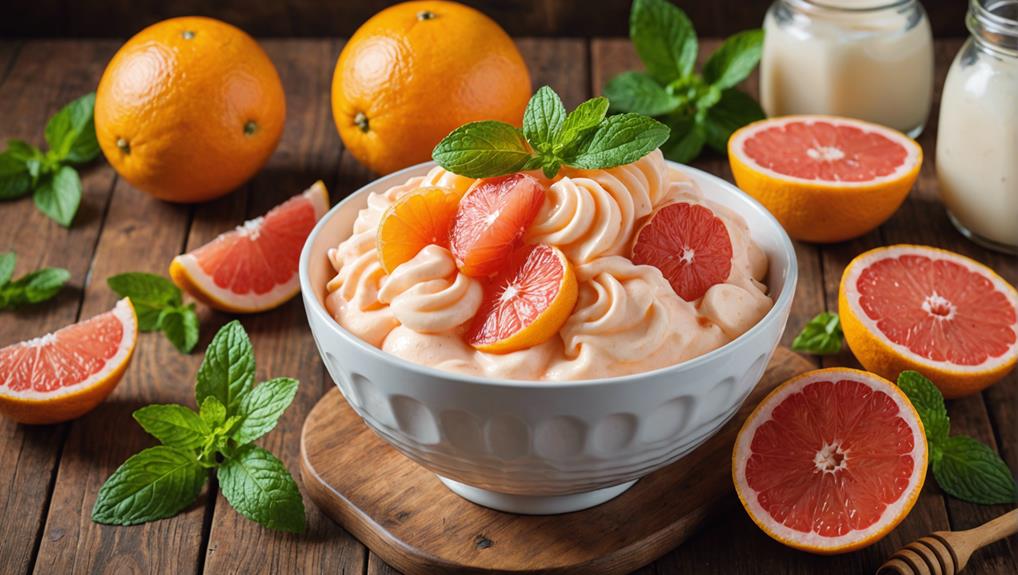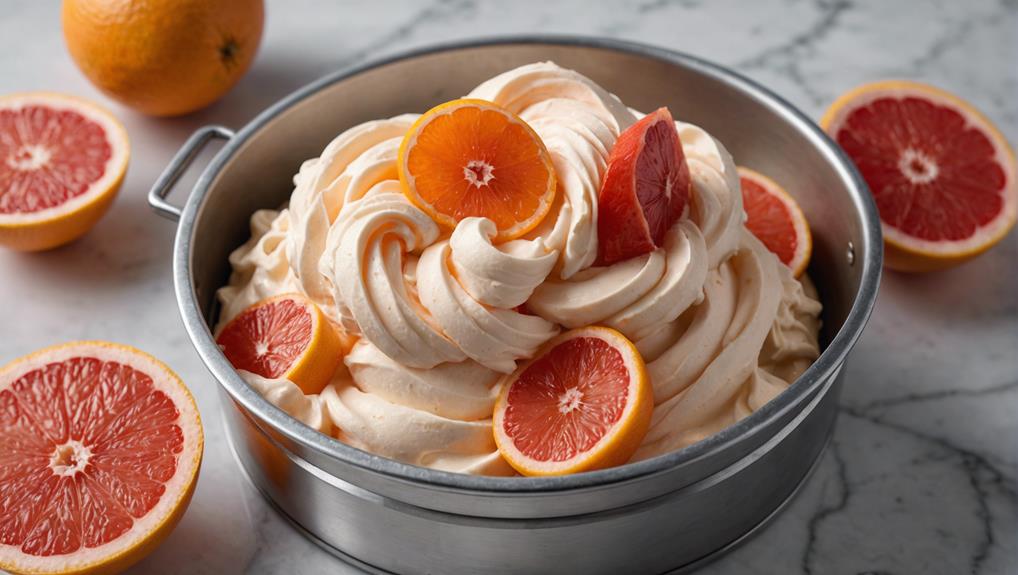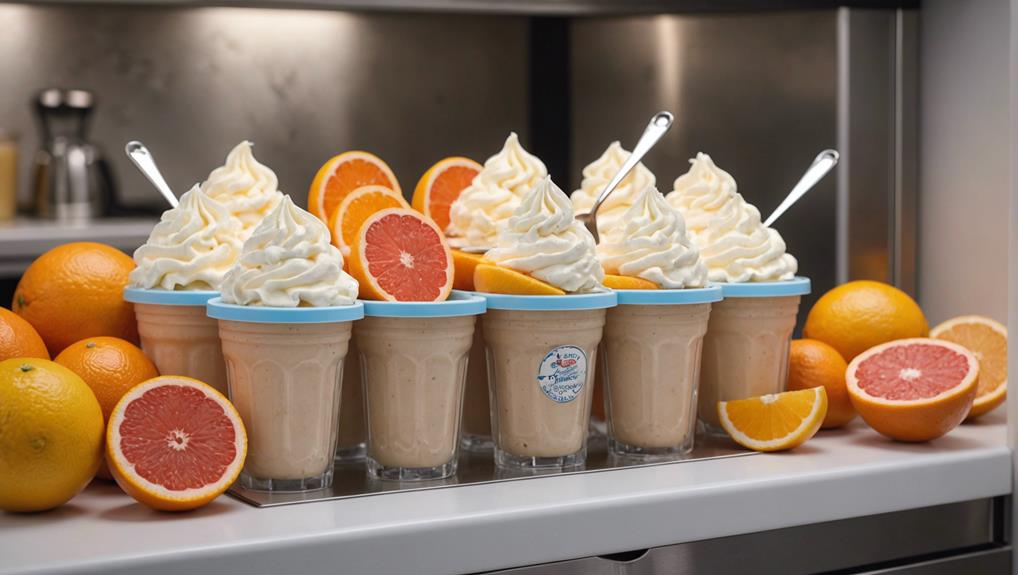Creating grapefruit frozen yogurt combines the zesty brightness of grapefruit with the creamy richness of Greek yogurt. Start by blending 2 cups of plain Greek yogurt with 1 cup of freshly squeezed grapefruit juice, 1 tablespoon of finely grated grapefruit zest, and 1/2 cup of honey. Add a teaspoon of vanilla extract and a pinch of salt. Pre-chill the mixture before churning it in a high-quality ice cream maker. Guarantee ideal freezing to achieve a smooth texture. Serve this invigorating dessert with fresh mint or crushed pistachios for an exceptional experience. For more tips on perfecting this treat, explore further.
Key Takeaways
- Combine 2 cups of Greek yogurt, 1 cup grapefruit juice, 1 tbsp zest, 1/2 cup honey, 1 tsp vanilla, and a pinch of salt.
- Pre-chill the yogurt mixture before churning in an ice cream maker to enhance texture and creaminess.
- Use fresh grapefruit juice and zest to achieve a balance of bitter and sweet flavors.
- Store the frozen yogurt in airtight containers at -18°C (0°F) to prevent ice crystals and maintain quality.
- Garnish with fresh mint, honey, or crushed pistachios for an elegant presentation.
Ingredients Needed

To create an invigorating and tangy grapefruit frozen yogurt, you will need the following high-quality ingredients. Begin with two cups of plain Greek yogurt, which provides a rich, creamy base while delivering a good source of protein and probiotics, essential for digestive health. Next, incorporate one cup of freshly squeezed grapefruit juice for its vibrant citrus flavor and high Vitamin C content. Enhance the tanginess with one tablespoon of finely grated grapefruit zest, adding a burst of aromatic oils.
To balance the tartness, add half a cup of honey, which not only sweetens naturally but also offers antioxidants and antibacterial properties. If honey is unavailable, agave syrup or maple syrup serve as excellent ingredient substitutions, maintaining the sweet profile without compromising the nutritional benefits.
For a smoother texture, mix in one teaspoon of vanilla extract and a pinch of salt, which will heighten the overall flavor. Additionally, consider adding a tablespoon of vodka to prevent ice crystals from forming, ensuring a silky-smooth consistency. Each ingredient contributes to a harmonious blend of flavors while offering a variety of nutritional facts that make this dessert both delicious and wholesome.
Equipment Checklist
An essential array of kitchen tools is required to seamlessly create this invigorating and tangy grapefruit frozen yogurt. Foremost, a high-quality ice cream maker is indispensable, guaranteeing the perfect texture and consistency, essential for achieving a harmonious flavor balance. Additionally, a robust blender or food processor is necessary to adequately puree the grapefruit, ensuring a smooth incorporation into the yogurt base.
Accurate measurements are critical in maintaining the delicate interplay of sweet and tart flavors. As such, a set of measuring cups and spoons is indispensable. A fine-mesh sieve will be needed to strain the grapefruit puree, removing any pulp and seeds, promoting a refined texture. Additionally, a zester or microplane grater is essential for extracting the zest, adding an aromatic depth to the frozen yogurt.
A mixing bowl and a whisk will be required for blending the ingredients seamlessly. For those keen on equipment maintenance, remember to thoroughly clean and dry each tool after use to prevent any lingering odors or flavors, which could disrupt the flavor profile in future culinary creations. By assembling and maintaining these tools, you ensure a delightful and efficient frozen yogurt-making experience.
Preparing Grapefruit

Selecting ripe, juicy fruits for the grapefruit is important to guarantee the frozen yogurt has the perfect balance of sweetness and acidity. Begin by understanding the nuances of grapefruit selection. Choose fruits that are firm yet slightly yielding to the touch, boasting a vibrant, even color. The skin should be smooth, without blemishes or soft spots, indicating the grapefruit is at its peak ripeness. Heft is another good indicator; a heavier grapefruit suggests a higher juice content, which is essential for a flavorful frozen yogurt.
Once the ideal grapefruits are selected, mastering peeling techniques is the next step. First, use a sharp knife to cut off both ends of the fruit. This will provide a stable base for peeling. Stand the grapefruit upright and, using downward strokes, carefully slice away the peel and pith, following the natural curve of the fruit. Aim to remove only the outermost layers, preserving the juicy flesh. For added precision, you may employ a paring knife to trim any remaining pith. This approach ensures a clean, bitter-free grapefruit, ready to be segmented or juiced for the frozen yogurt preparation.
Making the Yogurt Base
Crafting a rich and creamy yogurt base is essential to achieving the desired texture and flavor balance in grapefruit frozen yogurt. This critical step requires careful attention to detail to make sure that the yogurt develops the right consistency and tanginess. Start by selecting high-quality milk, as the foundation of your yogurt will greatly impact the final product.
To create the yogurt base:
- Heat the Milk: Gently heat the milk to 180°F (82°C) to denature the proteins. This step is important for achieving a smooth texture.
- Cool the Milk: Allow the heated milk to cool to around 110°F (43°C), the ideal temperature for adding yogurt cultures.
- Incorporate Yogurt Cultures: Introduce a starter culture, either from a previous batch of yogurt or a commercial yogurt starter. Ensure thorough mixing for even fermentation.
- Fermentation Time: Transfer the mixture to a warm environment and let it ferment for 6-12 hours. The exact fermentation time will depend on your desired level of tanginess, with longer times producing a more pronounced flavor.
Monitoring these steps closely will yield a yogurt base that is both creamy and tangy, providing the perfect canvas for the vibrant and slightly bitter notes of grapefruit in your frozen yogurt.
Combining Flavors

With the creamy yogurt base prepared, the next step is to infuse it with the vibrant and invigorating flavors of grapefruit. Grapefruit, with its unique blend of tartness and subtle sweetness, provides an intriguing flavor contrast that elevates the frozen yogurt experience. The key to a delectable grapefruit frozen yogurt lies in achieving perfect flavor balance, where neither the yogurt nor the grapefruit overwhelms the palate.
Begin by carefully extracting the juice and zest of fresh grapefruits. The zest, rich in essential oils, imparts a concentrated burst of citrus flavor, while the juice adds a revitalizing tang. To mitigate the inherent bitterness of grapefruit, a touch of natural sweeteners such as honey or agave syrup can be blended in. This not only enhances the sweetness but also complements the creamy texture of the yogurt base.
For added complexity, consider introducing subtle undertones by incorporating a dash of vanilla extract or a hint of mint. These elements provide a nuanced flavor profile, ensuring a harmonious balance. The interplay of creamy, tangy, sweet, and bitter flavors creates a sophisticated dessert that is as invigorating as it is satisfying.
Churning Process
Initiating the churning process is essential for transforming the mixture into a smooth and creamy frozen yogurt, ensuring a uniform distribution of flavors and an ideal texture. Whether you opt for an electric ice cream maker or the more traditional manual churning method, the goal remains the same: to create a luscious, velvety consistency that enhances the unique bitter-sweet taste of grapefruit.
To achieve ideal texture control, follow these steps:
- Pre-chill the mixture: Make sure the grapefruit yogurt mixture is thoroughly chilled before beginning the churning process. This helps in faster freezing and better consistency.
- Manual churning technique: If using a manual churner, turn the handle at a steady, consistent pace. This method not only allows for better texture control but also ensures an even freeze.
- Monitor the consistency: During the churning process, periodically check the texture. The mixture should gradually change from a liquid to a soft-serve consistency.
- Avoid over-churning: Over-churning can lead to a grainy texture. Stop the process once the desired creamy consistency is achieved.
Freezing Tips

To achieve the perfect consistency for your grapefruit frozen yogurt, it is essential to maintain an ideal freezing temperature of around -0.4°F (-18°C). Additionally, preventing the formation of ice crystals ensures a smooth texture, which can be managed by occasional stirring during the initial freezing phase. Lastly, for the best flavor and quality, consume the frozen yogurt within two weeks of preparation.
Optimal Freezing Temperature
For achieving the perfect texture in your grapefruit frozen yogurt, maintaining a freezing temperature around -18°C (0°F) is crucial. This temperature is ideal for balancing energy consumption and ensuring a smooth, creamy texture. Lower temperatures can increase energy consumption but provide a firmer texture, while higher temperatures may result in a softer consistency.
Here are four key points to keep in mind:
- Consistent Freezing:
- Keeping your freezer at a consistent -18°C (0°F) guarantees that the yogurt freezes evenly, preventing any undesirable textural changes.
- Energy Efficiency:
- Maintaining this temperature is energy-efficient, reducing unnecessary fluctuations that can lead to increased power usage and potential texture issues.
- Texture Effect:
- At -18°C (0°F), the freezing process is slow enough to allow the yogurt to develop a smooth and creamy texture, avoiding the formation of large ice crystals that can make the yogurt gritty.
- Storage Duration:
- Freezing at this temperature helps preserve the quality of the frozen yogurt over time, ensuring it remains delicious and safe to consume for an extended period.
Preventing Ice Crystals
An essential aspect of achieving a velvety consistency in your grapefruit frozen yogurt is employing techniques that prevent the formation of ice crystals during the freezing process. The key to maintaining a smooth texture lies in the careful selection of ingredients and methods that inhibit crystallization.
Stabilizer options play an important role in this endeavor. Incorporating natural stabilizers like gelatin or agar-agar can effectively reduce ice crystal formation by binding water molecules, thereby maintaining a creamy consistency. Another excellent choice is guar gum or xanthan gum, which offer similar benefits by enhancing the mixture's viscosity and stability.
The use of sugar alternatives is another strategy to contemplate. Traditional sugar not only sweetens but also lowers the freezing point of the yogurt, contributing to a softer texture. However, for those seeking healthier substitutes, agave nectar or honey can serve as effective sugar alternatives. These natural sweeteners provide the dual benefits of sweetness and a lower freezing point, which helps to prevent ice crystals from forming.
Storage Time Frame
Properly storing your grapefruit frozen yogurt guarantees it retains its best texture and flavor over time. Effective storage practices not only prolong the freezer duration but also guarantee the yogurt remains free from ice crystals and maintains its delightful taste. Here are some essential tips to help you maximize the shelf life of your frozen dessert:
- Airtight Containers: Use airtight, freezer-safe containers to prevent the formation of ice crystals. Make sure the container is filled almost to the top to minimize the presence of air.
- Freezer Temperature: Maintain a consistent freezer temperature of 0°F (-18°C) or lower. Fluctuating temperatures can cause the frozen yogurt to develop unwanted textures and affect its overall quality.
- Label and Date: Always label your containers with the date of preparation. This practice helps you track the freezer duration and ensures you consume the frozen yogurt before its expiration date, typically within 1 to 2 months.
- Avoid Frequent Opening: Minimize the number of times you open the freezer door. Each opening introduces warm air, which can cause partial thawing and refreezing, negatively impacting the yogurt's texture.
Serving Suggestions
Elevate the enjoyment of your grapefruit frozen yogurt by pairing it with a medley of fresh mint, honey drizzle, and a sprinkle of crushed pistachios. These pairing options not only enhance the complex flavors of the frozen yogurt but also add a delightful contrast in textures. The fresh mint provides a invigorating counterpoint to the yogurt's tanginess, while the honey drizzle introduces a subtle sweetness that balances the inherent bitterness of grapefruit. Crushed pistachios contribute a satisfying crunch and a hint of nuttiness, transforming each bite into a multi-sensory experience.
For those seeking alternative garnish ideas, consider incorporating seasonal fruits such as raspberries or pomegranate seeds. These fruits complement the tartness of the frozen yogurt and add a vibrant splash of color to your dish. Additionally, a light dusting of fine sea salt can accentuate the yogurt's flavors, offering an unexpected yet delightful twist. Edible flowers, such as pansies or violets, can also be used to add an elegant touch, making your dessert visually appealing and inviting.
To achieve a sophisticated presentation, serve your grapefruit frozen yogurt in chilled glass bowls or coupe glasses. This attention to detail will positively impress your guests and elevate the overall dining experience.
Storage Instructions

To maintain the ideal texture and flavor of your grapefruit frozen yogurt, it is important to store it in an airtight container in the freezer. Proper storage will not only preserve its delightful bitter-sweet taste but also guarantee that the creamy consistency remains intact. Here are some key considerations to help you store your frozen yogurt effectively:
- Container Types: Opt for high-quality, airtight containers made of durable plastic or glass. These materials prevent the formation of ice crystals and safeguard the yogurt from absorbing unwanted freezer odors.
- Portion Sizes: Consider dividing the grapefruit frozen yogurt into smaller, individual portions before freezing. This makes it convenient to serve and helps maintain the overall quality by reducing the number of times the container is opened.
- Labeling: Clearly label each container with the date of preparation. Frozen yogurt is best enjoyed within a month for the most favorable taste and texture, so keeping track of dates helps manage freshness.
- Freezer Placement: Place the containers in the coldest part of your freezer, typically near the back. This ensures consistent freezing and minimizes temperature fluctuations that could affect the yogurt's quality.
Frequently Asked Questions
Can I Use a Different Citrus Fruit Instead of Grapefruit?
Yes, you can use a different citrus fruit, such as oranges, lemons, or limes, for flavor variations. Fruit substitutions will yield unique and delightful results, enhancing the overall taste profile of your frozen yogurt.
How Can I Reduce the Tartness of the Yogurt?
To reduce the tartness of the yogurt, consider your sweeteners choice carefully. Incorporating honey, agave syrup, or maple syrup can effectively achieve tart reduction while adding a pleasant, complementary flavor to the yogurt.
Is This Recipe Suitable for Vegans?
In today's plant-based revolution, the recipe requires adjustments for vegan suitability. Replace dairy yogurt with plant-based alternatives and use vegan sweeteners. Such modifications guarantee the recipe adheres to vegan dietary standards.
What Is the Nutritional Information for a Serving?
The nutritional information for a serving includes a moderate caloric content, making it suitable for those mindful of their intake. Additionally, it is rich in vitamin C, providing a significant boost to your daily nutritional needs.
How Long Does It Take to Make From Start to Finish?
The preparation time, including initial steps, takes approximately 20 minutes. Following this, a chilling duration of around 4 hours is required, culminating in a total time of about 4 hours and 20 minutes from start to finish.
Conclusion
In the domain of culinary alchemy, the grapefruit frozen yogurt stands as a proof to the harmonious dance between bitterness and sweetness. Through precise preparation and thoughtful blending, this recipe transforms simple ingredients into a revitalizing symphony of flavors. The churning process, akin to a craftsman's touch, guarantees a creamy texture, while strategic freezing locks in the essence of each component. This creation offers a sensory delight, inviting all to indulge in a frozen masterpiece of contrasting yet complementary tastes.







